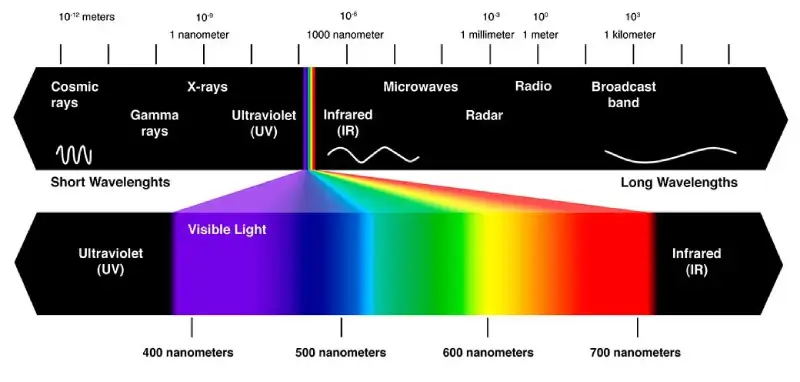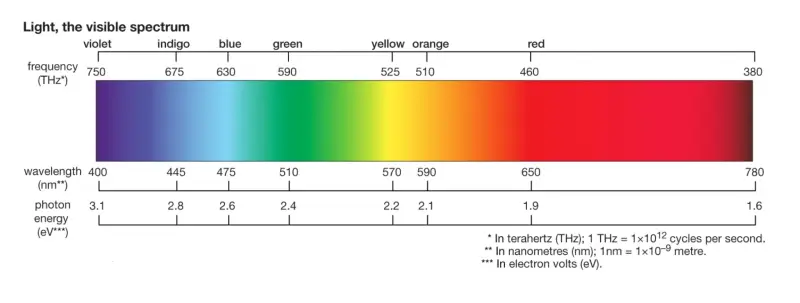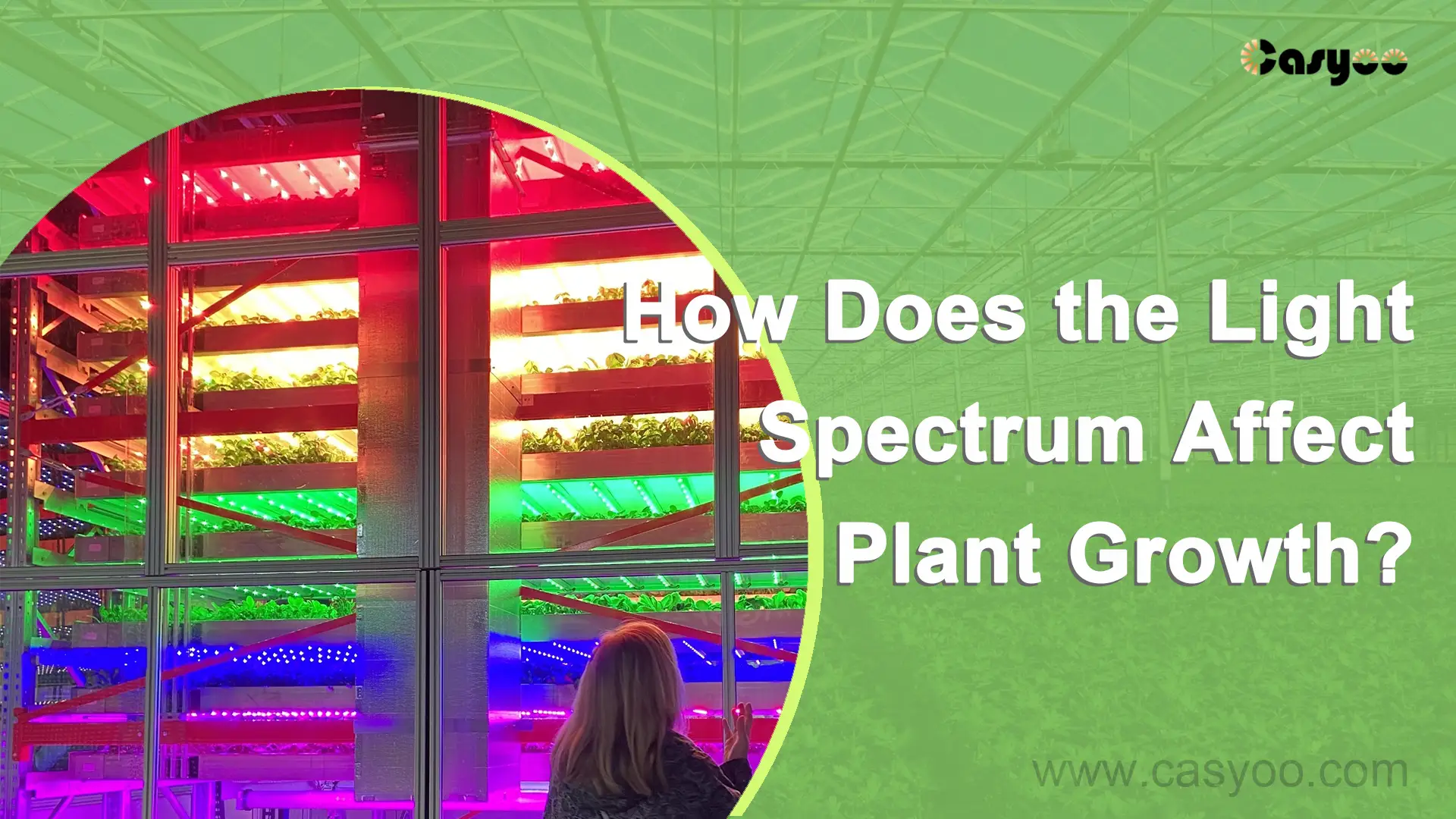Everyone will be excited when they see the multicolored rainbow in the sky. Science provides a compelling explanation for this process, citing the refraction of sunlight on moisture. Would you believe it, though, if we told you that the light spectrum is essential to plant growth?
Today, horticulturists know that these subtle differences in light across the spectrum have a major role in plant growth. Read this blog post to learn about the effect of the light spectrum on plant growth.
How Do Plants Sense Light?
Ever wonder how, in the absence of a brain or eyes, plants react to light?
Plants have a network of light-sensing photoreceptors that react to light energy falling on them within 380-750 nm wavelengths. More specifically, these leaves’ cells use the majority of the light they receive to produce food and adjust physiological functions.
The primary photoreceptors in plants are phytochromes, cryptochromes, phototropins, and UV-B. These receptors use light as a stimulus to control their life cycles and adapt to their surroundings.
These photoreceptors are found throughout the plant’s many sections, including the stems, leaves, and roots. When these photoreceptors are triggered by light, signaling pathways are set in motion, which results in modifications to hormone levels, gene expression, and other physiological processes.
How Does the Light Spectrum Affect Plant Growth?

Although we see the light from the sun as white, it is actually a mixture of several colors. Light has three primary colors: red, blue, and green. Plants respond differently to each light color.
Ultraviolet light (10nm-400nm)

Excessive exposure to UV radiation is indeed harmful, but small amounts of near-UV light can be good for the flora. UV light plays a significant role in the colors, tastes, and scents of plants because it contributes to metabolic activities. Research shows that 385 nm UV radiation has no discernible impact on growth processes, but it increases the accumulation of phenolic compounds and the antioxidant activity of plant extracts. Additionally, it has been shown that UVB raises THC levels in Cannabis.
Blue Light (400-500 nm)

Blue light promotes the opening of the “stomata” on plants’ leaves, which are responsible for letting out oxygen and taking in carbon dioxide. For photosynthesis to take place, there must be enough blue light to support ideal growth conditions. Blue light is related to plant circadian rhythms, which affect a range of physiological and metabolic activities over a day. Moreover, plants can blossom more when red light and blue light are combined because blue light acts as a regulator.
Farmers discovered that their plants were wider, stronger, and healthier than usual when they experimented with blue lights on them. This makes sense because it keeps plants dense and compact as they grow, making it ideal for small-space indoor applications.
Green Light (500-600 nm)
Since green light isn’t the main source of photosynthesis, many people consider it to be a minor factor in plant growth. Nonetheless, other morphological developments explain its significance.
The majority of plants appear green because they reflect green light instead of absorbing it.
Unlike red and blue lights, green light can penetrate further into the plant canopy to enhance photosynthesis in chloroplasts found on the leaf’s bottom surface and beyond. Thus, you may provide plants with a more organic and aesthetically pleasing atmosphere when you combine green light with a full spectrum grow light.
Red Light (600-700 nm)
Red light is essential to the process of photosynthesis since it is a basic part of the PAR (photosynthetically active radiation) spectrum. To be specific, this light is essential for the development of reproductive structures because it serves as a promoter of the blooming and fruiting.
This is due to the fact that plants’ photoreceptors absorb a lot of red light, which boosts the synthesis of a plant hormone, meta-topolin. Therefore, horticulturists can harvest more healthy crops when they strategically use red light in conjunction with other spectrum wavelengths.
Red light alone, on the other hand, would give the plant an elongated, stretched look with long, thin leaves. For optimal growth, it is recommended to utilize 80–90% red light and 10–20% blue light.
Far-red Light (700nm-850nm)
Although far-red light is not thought of as conventionally photosynthetically active and only slightly stimulates photosynthesis, the addition of far-red wavelength will influence plant growth because phytochrome photoreceptors, which are involved in the control of leaf expansion, flowering, internode extension, and the distribution of resources among organs, will absorb this light. In terms of the root to shoot ratio, far-red light will likewise have the opposite impact of blue light, leading to a higher shoot to root distribution. However, there must be a balance between an appropriate level of far-red light and an excessive amount.
Plants grown in intense far-red light may appear elongated and tall, and their leaves will become yellow due to insufficient chlorophyll content, which may not be good for their marketability. Apart from direct impacts, the proportion of red to far-red light plays a crucial role in controlling the reactions of plants. Since far-red light penetrates the canopy more than red light, plants that get more far-red light than red will perceive this as a shading effect and will respond by growing upwards to avoid the shade.
Yellow and Orange Light

Though they are frequently disregarded in the PAR spectrum, yellow and orange light are important for plant growth. Similar to how chlorophyll pigment absorbs red and blue light for photosynthesis, carotenoid pigment absorbs orange and yellow light. This helps plants absorb light energy and transfer it to chlorophyll, improving the efficiency of photosynthetic processes overall.
Particularly, orange light promotes the production of Auxins, which is responsible for cell elongation and healthy plant growth.
How Does the Light Spectrum Affect Other Organisms?
In addition to the effect of light color will have on plants, different light spectra may affect other organisms, such as those regarded as pests or pathogens.
Certain behaviors of disease and pest organisms are influenced by factors such as wavelength, photoperiod, and light intensity. This can have both beneficial and detrimental impacts, depending on the situation. For example, the proper light color might make it difficult for viruses and pests to survive, or it can provide the ideal environment for them to flourish.
Different light wavelengths can affect how insect perceive their environment and how quickly they reproduce. For example, UV light is essential for insect sight and is most effective in the UV-A region, which helps insect herbivores identify their target plants. UV-B and UV-C light can also negatively impact insect and fungal populations, lessening their impact. Furthermore, Specific wavelengths, such as far-red, may have an impact on some interactions between plants and pest species. In some cases, light-induced reactions in plants, such as the synthesis of phenolic compounds, may strengthen the plants’ natural defenses against herbivorous invertebrates.
Conclusion
The agricultural sciences have advanced significantly as a result of seasonal variations and sunshine limitations during high temperatures. Farmers today understand that thanks to LED grow lights, they can directly influence and increase the growth, result, and total production of their crops.
In order to customize light conditions and guarantee the best possible performance, cultivators must have a thorough understanding of the various grow light spectra and how they affect plant growth. Casyoo provides you with tunable full spectrum grow light to suit your plants in different growth stages. Don’t miss us!




